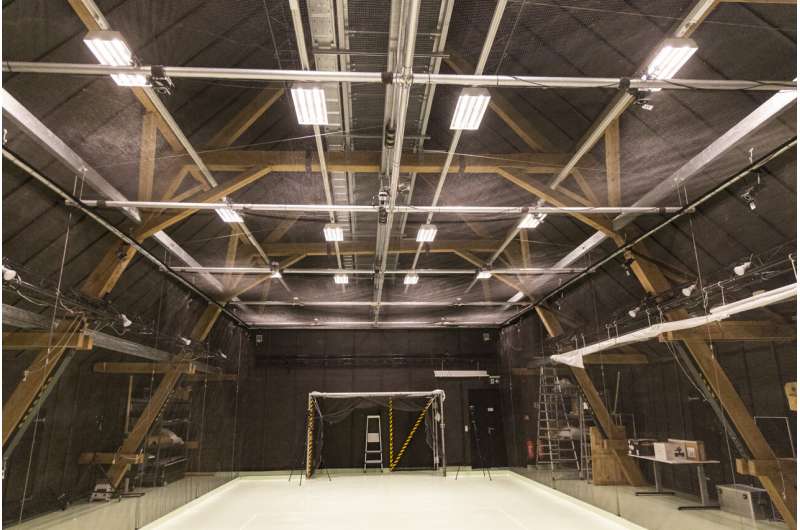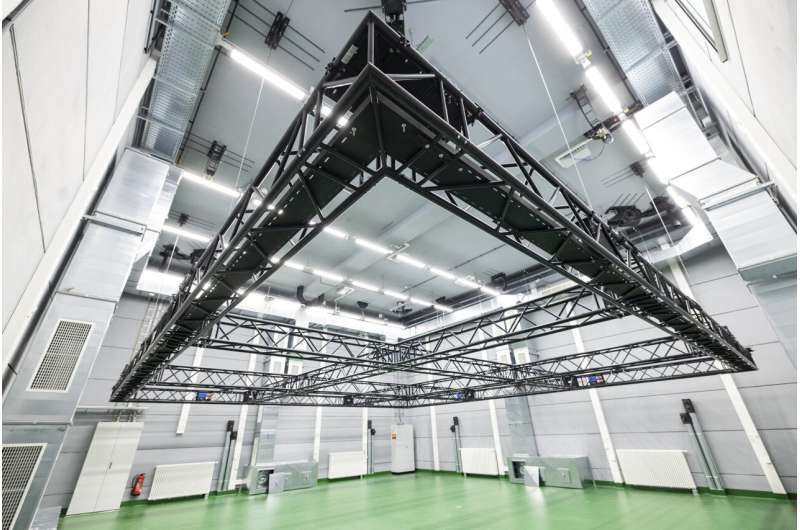SMART-BARN: A cutting-edge technology lab to study large animal groups

Researchers from the Cluster of Excellence Center for the Advanced Study of Collective Behavior (CASCB) and the Max Planck Institute of Animal Behavior have converted a former barn into a cutting-edge technology lab for complex behavioral analysis. In it, they can now study the intricate behavior of animal groups. The barn also served as a prototype for the largest swarm behavior lab at the University of Konstanz: the Imaging Hangar. Details have been published in Science Advances.
A major limitation in behavioral research is that scientists can either study animals under highly-controlled, yet often unrealistically simplified and small, environments in the lab, or in largely uncontrolled conditions in the wild. This has limited our ability to study many facets of behavior, including collective behavior鈥攖he movements and interactions among animals that underlie their complex social lives. What is needed to address this? First, a place with lots of space. Second, state of the art technology.
Both are available in an 18th-century barn at the Max Planck Institute of Animal Behavior in M枚ggingen near Konstanz and now in the Imaging Hangar, a hall the size of a gymnasium at the University of Konstanz. Both labs are used to closely examine the group behavior of animals. To do so in a multidimensional way, researchers from the Cluster of Excellence Center for the Advanced Study of Collective Behavior at the University of Konstanz and the Max Planck Institute of Animal Behavior have developed a tool called SMART-BARN.
SMART-BARN is an acronym for Scalable Multimodal Arena for Real-time Tracking Behavior of Animals in large numbers. "It is a new tool that allows studying complex behavior traits of an individual or interactions between groups of animals like insects, birds, or mammals," says Hemal Naik. Together with M谩t茅 Nagy, Co-Speaker of the Cluster, Iain Couzin, and colleagues developed SMART-BARN. The team was interdisciplinary: Biologists, physicists, engineers and computer scientists developed it together.
M谩t茅 Nagy explains, "We are using high throughput measurement techniques like optical and acoustic tracking, with which we can study the exact 3D position and posture of animals and calculate their field of view." Users of the new facility will have the flexibility to perform different experimental paradigms by leveraging the modular nature of the system.
Why scale matters
"SMART-BARN is designed to enhance the scale of typical indoor behavioral experiments in terms of experimental volume and measured behavior traits and group sizes," computer scientist Hemal Naik says and adds, "This means that users can measure previously unseen behavior repertoire because animals have more space."
The facility can鈥攄epending on the size of the animals鈥攈ost 100s of animals simultaneously and extend the possibility of experiments to novel species typically not studied in indoor environments. "In fact, we have now scaled this to work with many thousands of animals," adds Couzin, "We recently conducted a study in the Imaging Hangar where we tracked 10,000 plague locusts. This would have been impossible without our SMART-BARN technology."

How SMART-BARN can be used
So far, SMART-BARN was used within different experimental use cases involving subjects as diverse as pigeons, starlings, moth, bats, and humans. Naik is delighted because "the facility is shaping important new interdisciplinary collaborations." He continues, "For example, SMART-BARN offers the ability to track 3D gaze and posture of birds in a group of ten or more while maintaining their identity. This technique is being used by researchers to explore the role of gaze in decision making."
The same technique is used by computer scientists to design novel computer vision and AI based algorithms facilitating 3D tracking of animals without attaching any markers to them. "Our method has resulted in an even larger system in the at the University of Konstanz to track swarms of robots or thousands of insects," says Iain Couzin.
M谩t茅 Nagy says, "In a nutshell, the scope of its applications is only limited by our ability to come up with ideas of experimentation." The team imagines the facility to be a collaborative space where researchers from all over the globe can contribute to the exploration of behavioral questions. Therefore, the team invites researchers across the world to connect with them and plan experiments.
More information: M谩t茅 Nagy et al, SMART-BARN: Scalable Multimodal Arena for Real-time Tracking Behavior of Animals in laRge Numbers, Science Advances (2023). .
Journal information: Science Advances
Provided by University of Konstanz

















